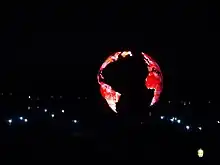Geoscope
The Geoscope was a proposal by Buckminster Fuller around 1960 to create a 200-foot-diameter (61 m) globe that would be covered in colored lights so that it could function as a large spherical display.[1] It was envisioned that the Geoscope would be connected to computers which would allow it to display both historical and current data, and enable people to visualize large scale patterns around the world.[2] Several projects by his students to build a "miniature Earth", starting with a 20-foot version at Cornell University in 1952, were precursors of the Geoscope proposal.[1] Before proposing the Geoscope, Fuller had invented the Dymaxion map, a novel map projection for the whole Earth.[1]

Many of Fuller's ideas for the functions of the Geoscope are now being realized by virtual globes.[1]
Fuller did not limit his use of the term "Geoscope" to the 200 foot (61 m) diameter globe proposed for installation near the United Nations in New York. He also used it to refer to smaller globes to be viewed from the inside outwards toward the stars.[3]
In Fuller's book Critical Path he advocated for constructing many Geoscopes as large see-through spheres shaped and oriented like the planet Earth. By standing inside, one could view the stars exactly as they appear to anyone standing at any point on Earth. Computers for each Geoscope will "store all relevant inventories of world data arranged chronologically, in the order and spacing of discovery, as they have occurred throughout all known history".[4] Time-lapse images projected onto the Geoscope would display in a matter of minutes all sorts of global, long-term trends, everything from continental drift to human migration to use of transportation. With the Geoscope humanity would be able to recognize formerly invisible patterns and thereby to forecast and plan in vastly greater magnitude than heretofore.[5]
See also
Notes
- DeVarco, Bonnie. "Geoscope". www.bfi.org. Buckminster Fuller Institute. Retrieved 2022-11-26.
- Buckminster Fuller Institute. "Geoscope quotes". www.bfi.org. Buckminster Fuller Institute. Retrieved 2022-11-26.
- Fuller 1981, p. 172.
- Fuller 1981, p. 180.
- Fuller 1981, p. 180–184.
References
- Baldwin, Jay (Fall 1990). "World Game". Whole Earth Review. No. 68. pp. 30–31.
- Fuller, R. Buckminster (1962). Education Automation: Freeing the Scholar to Return to His Studies: A Discourse Before the Southern Illinois University, Edwardsville Campus Planning Committee, April 22, 1961. Carbondale: Southern Illinois University Press. pp. 48–51. OCLC 184847.
- Fuller, R. Buckminster (1969) [1965]. "Keynote Address at Vision 65". Utopia or Oblivion: The Prospects for Humanity. Bantam Matrix Editions. Toronto: Bantam Books. OCLC 107190.
- Fuller, R. Buckminster (1981). "The Geoscope". Critical Path. New York: St. Martin's Press. pp. 161–197. ISBN 0312174888. OCLC 6735342.
- Keats, Jonathon (2016). "Planning: The Geoscope". You Belong to the Universe: Buckminster Fuller and the Future. Oxford; New York: Oxford University Press. pp. 93–114. ISBN 9780199338238. OCLC 917131678.
- McHale, John (1966). "Towards A Dynamic 'World' Education". In Mudd, Stuart (ed.). Conflict Resolution and World Education. World Academy of Art and Science book series. Vol. 3. The Hague: W. Junk. pp. 173–179. doi:10.1007/978-94-017-6269-4_20. OCLC 1093044.
- Pesce, Mark (2000). "The Green Goddess". The Playful World: How Technology Is Transforming Our Imagination. New York: Ballantine Books. pp. 237–246. ISBN 0345439430. OCLC 45132987.
- Sieden, Lloyd Steven (1989). "Expanding the View". Buckminster Fuller's Universe: An Appreciation. New York: Plenum Press. pp. 241–269 (especially 259–269). ISBN 0306431785. OCLC 18963281.
External links
- Fuller Dome – Geoscope-like geodesic dome at Southern Illinois University Edwardsville